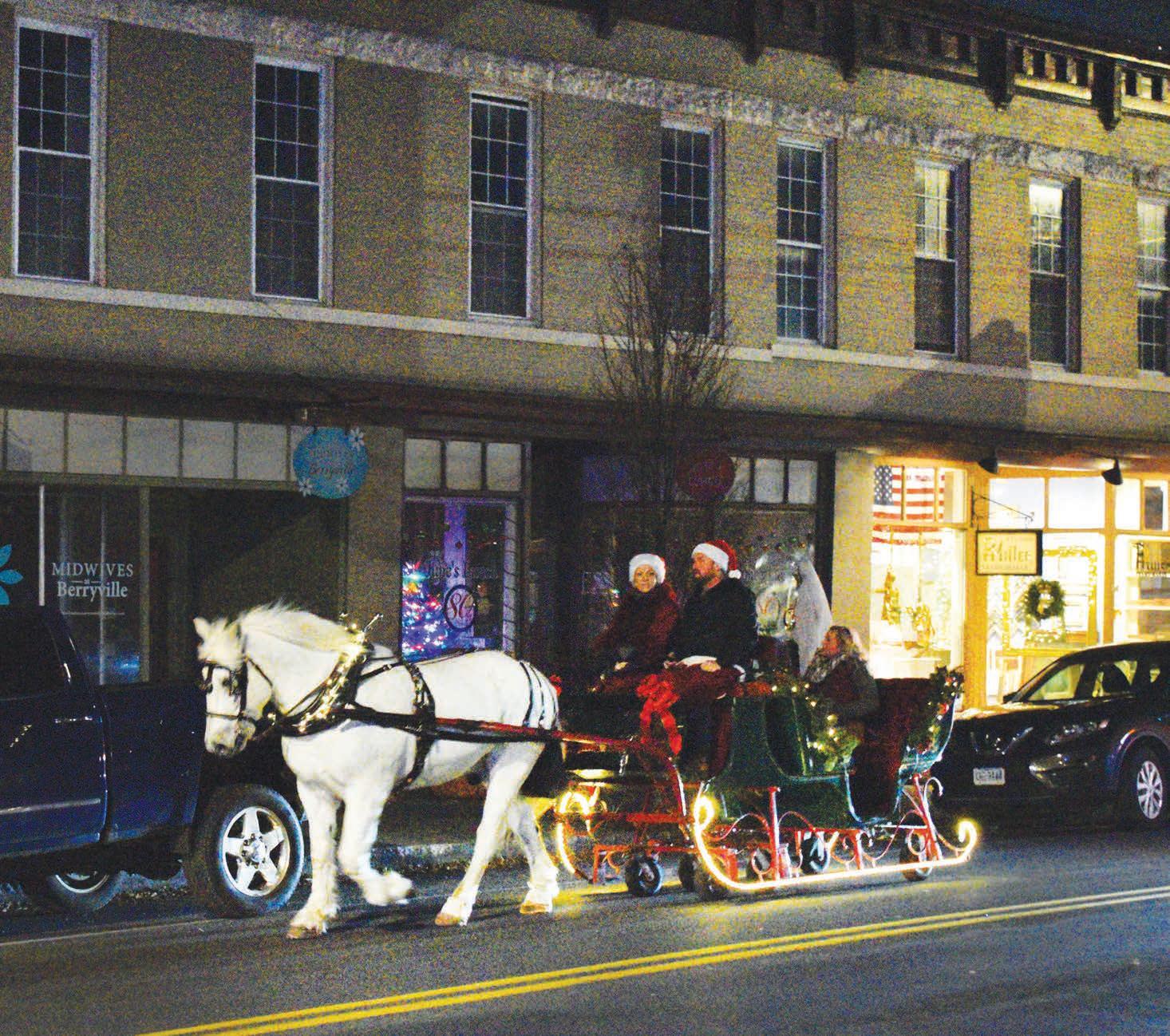









 By Cathy Kuehner
By Cathy Kuehner










Larry Hardesty was named the 2022 “Berryville-Clarke County Veteran of the Year” during the annual Veterans Day program on November 11 at the Berryville-Clarke County Government Center. Supervisors Chair, David Weiss, presented the award – always a surprise to the recipient — that is “bestowed in recognition of the local veteran who best exemplifies the tradition of citizen soldier whose dedication to our nation and community does not end when his or her military service is complete.”

Hardesty was raised in Clarke County’s Wadesville community. After graduating from Clarke County High School, he entered the U.S. Army in July 1966,










trained at Fort Gordon, Georgia, and was then assigned to Fort Belvoir, Virginia, where he completed Military Police training. He served at Fort Belvoir in a variety of active duty assignments until July 1968. He remained on active reserve duty until July 1970.



After working in construction, Hardesty became supervisor of maintenance and transportation for Clarke County Public Schools. Since his retirement in 2008, he has served on the board of the Clarke County Memorial Cemetery as treasurer and president. In 2011, he established Stone’s Chapel Memorial Association and currently serves as its president. Since 2020, he has served as president of the Green Hill Cemetery.
Hardesty has been an active member of the Clarke County Retired Teachers Association, and currently serves as an Officer of Elections for the Russell District in Clarke County. He is currently the First Vice Commander of American Legion Post 41 Berryville, VA, where he chair of the Building and Grounds Committee. He helps install military markers at various gravesites in the county.
Previous “Berryville-Clarke County Veteran of the Year” award recipients are Norman Dev Morrison (2015), John Harris (2016), Michael Linster (2017), Robert Ferrebee (2018), Chris Shipe (2019), Will Nelson (2020), and Thomas Vorisek (2021).





I have to acknowledge, there were many years in which I had a hard time with Christmas. It wasn’t about the gift giving. I enjoy roaming the shops of Berryville and nearby small towns at Christmastime in search of presents that I feel will have meaning for the people I care about. It’s an opportunity to connect in a small way with friends and family. Birdhouses and bird art for Mom, a handbag for my daughter who designs packs and bags, primitive cat-themed art for Grandma,. Offering a little something that was hand-crafted by an actual human, preferably a local person, is a sort of intimate sharing. It can say, “I get you.”

And I enjoy the time with family and friends — and all the holiday food! I’ll gain a few pounds and I don’t care. I’ll work them off in January.
I used too get all funky about how commercialism detracted from the meaning of Jesus’s birth, kind of like Charlie Brown. A born curmudgeon, I resisted even mentioning Santa to my kids because I knew there were awesome kids out there wondering why Santa didn’t hear them.
A dear friend, Bob, helped me rediscover Christmas. Bob is the longtime choir director at his church and, until recently, a 50-year scoutmaster. Bob told me to get over it. Give your
love, he said. Sit with your elders and hear their stories. Be present with your children — don’t just give presents. If you can afford it, write a couple checks to local charities. Hug your family whose opinions disrupt Thanksgiving supper. Remember that the meaning of the Nativity is a call to love. Bob is a smart guy.
In the end, as the song says, the love we take is equal to the love we make.
Wishing you a blessed Christmas, for all of our readers in this tradition. And love and understanding whatever your faith and understanding. Be well.
— David Lillard
November’s article about Balclutha contained a number of errors.The corrections appear below.
Warner Washington 1 (1715–1790) moved to Frederick (now Clarke) after the death of his first wife. He lived at Fairfield.
Warner Washington I was a cousin of George Washington.
Warner Washington I conveyed part of the 1600 acre property known as Fairfield to his son Warner Washington II (1750-1826).
The property given to Warner Washington II became known as Clifton. Balclutha was built c. 1844 by David Hume Allen, the thenowner of Clifton, as a gift for his son William Temple Allen. It was never an independent farm until c. 1905 when it sold by Bushrod Corbin Washington III (who was married to William Temple Allen’s daughter, Emma) to a nonfamily member.
Clifton was subdivided and sold after WW2’s (1750-1826) removal to Audley c. 1796. By 1801, Clifton (the house) and 683 acres had been acquired by Griffin Taylor. The daughter of Griffin Taylor, Sarah Griffin Taylor, married David Hume Allen and, following the death of Griffin Taylor in 1818, Clifton became home to the Allens.

 By Cathy Kuehner
By Cathy Kuehner

Mark your calendar for Sunday, January 15, and plan to celebrate Berryville with your friends, neighbors, and special guests at a community gathering.
The Berryville 225th Anniversary Committee has been meeting since February 2022 to plan special events throughout 2023, and it all begins on January 15, the day the town was officially chartered in 1798.
The “Berryville Celebrates” Birthday on Sunday, January 15, at JohnsonWilliams Middle School is free and open to the entire Clarke County community. The school is located at 200 Swan Avenue.
The afternoon program begins at 2pm with activities for children and displays, including the “Ber-

ryville Celebrates” quilt made as a fundraiser by the Apple Valley Needle Threaders quilting club. Raffle tickets are $5 each, and proceeds will fund other anniversary events in 2023.
The program moves into the J-WMS auditorium at 3pm, when special guests and featured speaker Maral Kalbian celebrate Berryville’s past, present, and future with photographs, presentations, an audience-participation trivia quiz, music by the Clarke County Community Band, and commemorative gifts for everyone in the audience.
“Excitement over Berryville turning 225 has been building for months leading up to the inaugu-
ral event on January 15,” said lifelong Clarke County resident John Hudson, who chairs the anniversary committee. “I can’t wait to see everyone there, helping us celebrate with speakers, music, activities, and history that may tell you things you didn’t know about our wonderful town.”
Architectural historian Kalbian, who has a new book about Clarke County coming out in 2023, will give brief overview of the town’s history accompanied by historical images that will give perspective to the town’s development. Her research over the past three decades builds on work by previous historians and includes visual documentation of homes, schools, and commercial

buildings throughout the county and its seat, Berryville, as well as old letters, first-hand accounts, deeds, and insurance maps.
More than 100 years ago, Thomas Gold wrote a history of Clarke County that has served as a resource for others since its publication in 1914.
Gold’s chapter on Berryville, at one time known as Battletown, begins, “Very soon after the first settlers arrived in the county, or even before, the roads or trails seemed to fall naturally into certain places. Pioneers and travelers from the eastern settlements crossing the mountains, made for Winchester, even then a village, by the most direct line, and persons from the lower neighborhoods on the Blue Ridge and below having business with his Lordship [Thomas Fairfax, 6th Lord Fairfax of Cameron] at ‘Greenway Court,’ sought him by the easiest route. These paths crossed each other, and there some enterprising person opened a tavern and another a blacksmith shop, and later a store. Here the young men gathered to drink and play and, very naturally, where law had not much force, to quarrel and fight.
“Nearby was the home of Daniel Morgan, and no one was fonder of his drink than he and no one quicker to resent an insult, real or fancied. So the cross roads settlement was called
Battletown, and for many years continued to bear that name among the older people, who were loath to adopt the name Berryville given it by the gentleman who had it laid out,” Gold wrote.
He continued, “In January 1798, it was established as a town on twenty acres of land belonging to Benjamin Berry and Sarah Stribling, and the following gentlemen were appointed trustees: Daniel Morgan, Wm. McGuire, Archibald Magill, Raleigh Colston, John Milton, Thomas Striblinger, Geo. Blakemore, Chas. Smith and Bushrod Taylor.
“In 1803, another addi-
ment in 1842, and a third in 1870, when a large addition from the property of J. Rice Smith, embracing all that part of the town north of the Winchester Turnpike, and west of the property of the Showers family,” Gold wrote.
Berryville continues to grow in the 21st century, so understanding how the Town has developed adds perspective to contemporary life. It also explains many street names throughout the town: Cameron, Fairfax, Josephine, Rice, Smith, Treadwell, and others named for the people who shaped Berryville. Thomas Gold’s 1914 book included this in the chapter about Berryville: “Telephone lines run in every direction, and you can talk to your friends in the distant cities if you wish. An electric light and power company can furnish you with light for your house, power to run your machinery, and heat to cook your food.”
tion was authorized by the Legislature from the property of Chas. Smith, on the east side of the town, and again a second enlarge-
Much as Mr. Gold would be astonished to see today’s smartphones, homes, transportation system, and technology, it is impossible to predict what Berryville and Clarke County will look like in another 100 years. Still, the January 15 “Berryville Celebrates” birthday program will include a look toward the town’s future while the community collectively marvels in how far it has come in only 225 years.
600 EAST MAIN STREET BERRYVILLE 540-955-1900


703 N ROYAL AVE FRONT ROYAL 540-635-2547



Kelly is a delivery driver by day and cleans offices at night to supplement her income. She makes enough to cover expected expenses but still only just scrapes by each month and can’t save for an emergency. “I work two jobs to pay my bills — rent, insurance, car, phone, and some old medical bills. But now I have $2.87 in my bank account and my electric is about to be cut off. I need some help.” Kelly shared this a few months ago when she reached out to the United Way of Northern Shenandoah Valley’s direct services program, Valley Assistance Network (VAN).
Along with 41 percent of Clarke County residents, Kelly is ALICE: Asset Limited, Income Constrained, and Employed. ALICE represents the growing number of families, locally and nationwide, who are working, oftentimes multiple jobs, but unable to afford the basic cost of living.
United Way of Northern Shenandoah Valley hosted its 5th annual ALICE Awareness Week November 26 through December 3 with to raise awareness surrounding the struggles and resilience of ALICE families in our community. The week included sharing stories from people like Kelly who received help through the ALICE Emergency Fund (AEF). This flexible fund provides one-time grants of up to $500 to help families overcome emergencies and stabilize so they can move toward self-sufficien-
cy. Since 2018, the ALICE Emergency Fund has helped 45 families with $21,130 in direct relief. All AEF funding goes to families in the Northern Shenandoah Valley, and half of recipients are single parents.


A $500 investment in the life of someone with no safety net makes the difference between getting to work or losing a job, explains Jennifer Hall, senior director of Community Investment with UWNSV. “ALICE families often do not make enough to save so a car repair or illness can send them into crisis.”
Since September of this year, when it increased its presence in Clarke County, United Way NSV is seeing a rise in the number of families accessing assistance. Resource Navigators from the VAN program connect families with partners locally and across the state that can assist with a variety of needs related to housing, veterans’ services, employment, and more. The most common requests for assistance are housing related — rent, mortgage, and utilities — things that are quickly becoming beyond reach for many.
United Way NSV staff visit the Clarke County Department of Social Services on the first Wednesday of every month to answer questions and assist with referrals for ALICE families. In this way, the VAN program has helped 22 families connect with resources in just the last three months. That’s nearly dou-
ble the number of clients from just a few months ago.
“We anticipate a notable increase in these statistics to be released in the 2023 report. Overall, our VAN program has seen a 70 percent increase since 2021 in residents needing assistance with basic necessities. Many families are finding themselves in need of assistance for the very first time.” says Kaycee Childress, president and CEO of United Way NSV. “Inflation is hitting all of us, but ALICE families who were already walking a financial tightrope are being hit especially hard.
“Four in ten households don’t make enough to afford housing, food, childcare, healthcare, transportation and a cell phone. The spike in food and gas prices, coupled with rising rent in our area is making it extremely challenging for ALICE families to stay afloat, especially single parent households and others with just one income,” Childress said.
The increases have been staggering for the VAN team who is working overtime to keep up with the demand. Volunteers are a crucial part of the United Way NSV’s mission and are needed at VAN, now more than ever. If you’re interested in helping, contact Abby Zimmermann at (540) 773-3178 or azimmermann@unitedwaynsv. org. For information about ALICE or to donate, visit: www.unitedwaynsv.org/ aliceawareness.
 Story and illustration by Doug Pifer
Story and illustration by Doug Pifer


I stepped outside with one of our dogs at about 8pm and almost immediately heard a piercing wail followed by a wild series of yaps, chatters and yelps. It seemed to come from the field beyond our neighbor’s house. The dog never lifted his head from whatever he was sniffing. He’s heard coyotes many times before.
Later in the evening when I took the dogs out before bedtime, I heard the chorus again. It was coming from a distance, beyond the woods behind our house. I wondered whether these were the same or different animals.
The dynamics of animal sounds are more fascinating the more we learn about them.
For example, scientists have recently learned that some animals we thought were silent, such as turtles and fish, communicate with their own unique sounds. Even the wellstudied sounds of birds and coyotes have many secrets to reveal and mysteries to solve. For example, how can two or three coyotes howling at night sound like a dozen or more?
This phenomenon of one animal sounding like many is called the Beau Jeste effect. In the novel by that name, author Perceval Christopher Wren describes how an army of French Legionnaires decided to prop up their fallen comrades to make the enemy think their army was bigger than it was. The term was first applied to male birds that sing several different songs at different places. Supposedly this gives the impression that the place is occupied by many individuals, thus keeping away competitors.
Here’s how coyotes use the Beau Jeste effect. Mated pairs tend to stay together with their young of the previous year. One coyote, generally the male, gives an opening howl, followed
by his mate and then their young chime in. Each individual varies the pitch and intensity of their calls. Waves of sound in various pitches and frequencies bounce off rocks and trees and even nearby buildings, and then echo through hollows and
valleys. Such reverberations from the howls of a very few animals can lead many folks to claim the country is “overrun” with them.
Over the past 20 years, coyotes have virtually taken over the eastern half of the United
States. Their numbers appear to be growing not only in the wooded and agricultural regions but also in cities and suburbs. The howl of the coyote, once iconic to the Old West, is now heard in New York City, Washington D.C., and Atlanta.
Their adaptability to a variety of habitats and their tolerance of humans have made coyotes subject to such outdated methods as bounty hunting and poisoning campaigns.
Coyotes will probably always be controversial. Many people hate them for attacking pets and livestock. Coyotes are very flexible in their diet and even crops of melons and other fruit are subject to their depredations. And while many stories of their depredations are exaggerated, coyotes do real damage to livestock, particularly to sheep during lambing season. Combined with their ability to live almost anywhere, this places them in direct competition with us. Many states allow people to hunt coyotes anytime and anywhere, yet coyotes survive.
My wife and I have no doubt lost some of our poultry to coyotes, and we have watched an adult coyote chase a fawn, stalk wild turkeys and kill a groundhog in the hayfield behind our place. Coyotes learned to tolerate our presence and go about their business in the open, in plain view of us. I admire them for their success in bringing a touch of the wild back into our lives.
Blandy Experimental Farm. 400 Blandy Farm Lane. Boyce. Enjoy a mug of hot chocolate or tea and meander through Blandy’s conifer collection with a naturalist. Wear comfortable shoes and dress for the weather. Registration required. FOSA members $10, nonmembers $15. 2–3pm. www.blandy.virginia.edu.


Trinity Episcopal Church. 9018 John Mosby Highway. Upperville. 42nd season introduces Dr. Bryce Hayes, artistic director. Enjoy Christmas with Viva Through the Ages, A Cappella works from Renaissance to Pop. $15, students free with ID. 7:30pm. www.winchestermusicviva.org.

Check the John H. Enders Fire Company Facebook page for upcoming
details on Santa’s route through Berryville. 5pm. www.endersfire.com.
Audley Farm. 752 Audley Lane. Berryville. Local vendors, Roaming Bistro food truck, Enders Fire Company fundraiser and raffle, and pictures with Santa. 9am–1pm. www.audleyfarm.com.
Clarke County High School. 627 Mosby Blvd. Berryville. Enjoy a Christmas concert to benefit Chains of Checks. 7pm. www.clarkecountycommunityband.com.

Shiloh Baptist Church. 1983 Millwood Rd. Holiday food to fix, dairy products, personal care items and snack packs, and food to take home “from our community table to your family table.” Find out what benefits may be available to you from the Department of Social Services. Held monthly.

Free. 9–11am. 540-955-1823. www.fishofclarkecounty.org.
17Family Ornament Making


18Winchester Musica Viva Chamber Choir Concert

to join vivid music making with warmth and intimacy onstage to produce a new kind of listening experience, in which great works come to life with authentic emotional power. $25 in advance, $30 at door. 7–9pm. www.barnsofrosehill.org.
Ongoing
17Astronomy for Everyone
17Country Christmas Concert
18Clarke County Community Band Concert
23Christmas by Candlelight
January 7 Brian Ganz Concert
Mindful Meditations and Musings

17Make a Toy Workshop
Veterinarians:
Dr. Rachael Nuzzo, DVM, Owner
Dr. Brittany Jones, DVM
Dr. Holly Nightingale, DVM, CVA Dr. Erin Rockwell, DVM
Phone: 540-955-2171 • Fax: 540-955-1716

Now accepting new patients!


You know what sets homo sapiens apart from every other species? We’re the only ones where the male spends his life trying to win his father’s approval. Doesn’t matter if he’s a bank robber, an ax murderer, even a politician or worse. You want it. My dad was a good guy. He lived into old age, but I never knew where I stood with him until what he said to me just before he died. He was gone with dementia, but I’ll take him at his word.

I always think of this at Christmastime. Dad’s last Christmas in 2017 was joyous. We all knew he had little time left after months of steady decline. But he staged a classic rally, laughing and, at times, able to join in a conversation for fleeting moments.
His first signs of memory loss, in his early 80s, began in familiar ways. Out on an errand, he forgot his way home. Then it happened again. We got him a cell phone for these occasions, but he would forget he had it or how to use it.

As is often the case, his descent came in phases; he would settle into a plateau for a few months, then take a steep drop. He lost track of himself. Once, when my mother was volunteering at the soup kitchen, she came home to find him asleep in a chair in front of the fire place, as the roaring fire he had lighted threw sparks onto the carpet. He had forgotten to close the glass doors. After that, Mom put a decorative arrangement in the fire place and shut it down.
Soon, he was only partially with us. He might recall something from long ago with clarity. He could recite FDR’s December 7 speech and sing

jingles from the 50s. Then he’d tune out and in from another world. Over several visits in the autumn of his last year, when he could still sit and chat, he told me his remarkable history of saving lives. Stories from television news and random circumstances, with him at the center. Stories like these.
Once, as a passenger on a plane, he told me, he had kept his cool when the pilot was forced to make a water landing. My father led the evacuation.
In some stories, the details were exhaustive and complex. Like the time on our annual beach vacation; I was 12 or 13 years old, he said. We had been standing at the water’s edge watching tiny mollusks bury themselves after each wave when suddenly he ran into the water. He called over his shoulder, “Get the lifeguards.” As
he dove in and swam toward the sea where a young boy was foundering, I ran to the guard stand, gesticulating in the direction of my father, unable to speak. In an instant, one guard radioed support as the other darted into the surf. Seconds later, two guards appeared, one from up the shore, the other from down, and dragged a dinghy into the water.
When the guards reached them beyond the break, my father helped get the boy into the boat and gave the thumbs up, then watched as they headed ashore. With eyes and attention on the boat and the boy, it was easy for Dad to drift in the current unnoticed, then come in on a wave a hundred yards south and saunter over the sand to the boardwalk.
At the guard stand, people were asking, “Who was that





Dementia couldn’t rob him of Christmas, nor of my memoriesPop Pop Thomas Joe Lillard and grandson Cooper.
man,” and, “Where did he go?” To which a woman, pointing in the direction of the boardwalk, confirmed, “He swam in and went that way. I guess he didn’t want any attention.”
Apparently, I had said nothing back at the blanket, where my brother asked what was going on. “The guards saved some kid,” I had said.
In his stories, that’s the way it always was: He just disappeared. He was there; then he was gone.
Like the time he ran into a burning house and carried two small children out, handed them to neighbors, then ran through the smoke and flames to rescue their mother.
When the television crews arrived, all anyone could talk about was the guy who saved the family. For days, news reporters would return to the scene to ask, “Who is he; where did he go?”
All these things actually happened — just without my father’s participation. His role was in the remembering. Remembering decades of our lives in the suburbs. Memories I might have forgotten had he not retold the stories from his new perspective.
Sure, we had witnessed rescues at the shore over the years. The guards, as in my father’s recollections, acted with the precision of a special ops unit. As for the fire scene, hardly a week passed without the local 11 o’clock news broadcast opening with, “Tonight there’s a fire in the Kensington District.”
Truth is, my father had risen to acts of true bravery, ones I witnessed and still recall. Like an episode at a lake one summer. A group of teenage boys were harassing a woman standing in the shallows. We couldn’t hear what was said, whether she had aggrieved them in some way, but when the four of them moved closer, and one touched the woman’s arm, my father leapt from his chair and pulled the leather belt from his shorts stowed in a canvass tote.
In a few seconds he stood between the woman and the boys. He didn’t raise the belt, but he let them see it. Like he was going to give them a fatherly whipping, as men did back then. A woman next to us said, “That man is going to get himself killed.” The man with her, who had the look of an aging Navy Seal, replied without taking his eyes off the scene, “If those kids know what’s good for them, they’ll walk away.”
One of the boys made a pathetic gesture of vulgarity in defeat, feigning toughness. They walked up the beach. Dad exchanged a few words with the woman. When others gathered around her, he retreated to the blanket, put the belt away, and sat down, saying nothing. My brother and I broke into laughter. We knew that belt well; the thought of seeing someone else on the other end of it was pure joy. “You should have made them dropped their trunks and given them one on the butt,” my brother said.
This actually happened. That’s the way I remember it anyway. The odd thing is, he didn’t seem to remember it at all when I brought it up.
He did, in fact, usally disappear. In all his imagined stories, the disappearing act is the part that we saw every day.
He didn’t go off on benders like some men, or spend every Saturday on a golf course. He retreated to his favorite room, the bathroom he installed in the basement. His hideaway to soak away the arthritis inflamed by being a working man. And to wash away the monotony of life.
He kept a calendar on the wall there, marking each day with bold X from corner to corner. There were no events noted on this calendar — only X after X. Was he marking days until he could retire? Or was it his own profane gesture to universe? “I made through another one; you didn’t get me today!”
Perhaps bath time informed his imagined stories, the part
he cherished most, the part when he could disappear — leaving the scenes of his heroics to be alone. In his bathroom sanctuary, he was alone for a time, so that he could emerge later a bit cheerier.
Finally, his body gave out. That’s part of the process. We often think of the mind and body as separate things. They’re not. As the brain fails, the body follows suit. He lost mobility. In this last weeks, he spent much of the day in a hospital bed in my parents’ television room. Sometimes, he would get up and walk into the living room, which was crazy because he really was an invalid by then. A bit of unconscious muscle memory would have him rise and wander long enough for us to secure him before his legs gave out.
He rallied for Christmas, staying up late surrounded by his seven kids and 12 grandchildren and several great grandchildren. He smiled, had his picture taken a hundred times. With Santa, the grandkids, big smiles. A few times he spoke, like he was right there. Remembering. At peace.
After Christmas, he took to his bed and slept. It was as though he had mustered all his strength for one final Christmas, and then declared it was time move on.
On a Thursday afternoon, I sat by his bed offering sips of water or ice chips. If he spoke, it might be about people wandering in the backyard — people who were not there. Mostly he slept or stared vacantly at the window.
I sat there working — that’s what you do. You occupy yourself with your own day as a way of consoling yourself. “This is death; this is normal.”
I was consulting with a water policy advocacy group. That afternoon, I was on the phone working out a press statement. Political media is tedious, espe-
cially on the phone. You trade phrases back and forth. Like, “This bill would allow more cancer causing chemicals in our water.” Your counterpart on the other end massages the language and you read it back. “This bill is a race to the bottom in public health, and will jeopardize our clean water economy.” Stuff like that.
After I hung up, he whispered, “Water.” I raised the cup to his lips. He shook his head; he didn’t want water. I offered ice chips. No to the ice chips.
“Water,” he said again. He made a faint gesture with his hand toward me. He looked straight into my eyes for what must have been less than a second but is now part of me. He said good, or you, or something that sounded like good, goo, or woo, I don’t know. That
part, I don’t know. Water, and his eyes, the gesture. That I know. He nodded faintly, once.
I sat wondering if I had imagined this; I decided I hadn’t. I decided he had been listening. He understood my calling: safe water for everyone. All men, after all, want to measure up in their father’s eyes. I felt then, and today, that he approved.
I kissed his head, bald like mine, then drove the three hours home, planning to return on Sunday.
Sometime after 3am Sunday morning, my sister let me know he was gone. I packed a suit, and before the January sun rose, took a long walk along the Potomac River. Water.
It was a Christmas season I will always treasure.
You depend on us to keep the lights on 24/7. That’s why we work around the clock to safely provide you with the most reliable, affordable power possible.


Last year alone, crews cleared more than 1,500 miles of right-ofway areas and removed 27,000 hazard trees. Tree maintenance is ongoing and crews continue to upgrade equipment in the power delivery system.
Why? Because reliability is everything.

upon us, and if you’re considering Amazon or a big box store for that perfect gift for someone in your life, consider keeping it local and heading to Unique Creations Studio in Berryville for a handmade gift you won’t find anywhere else.


Jessica Dove opened the studio’s original location more than three years ago in Waterloo (the intersection just past Boyce on Route 340 South), but a recent change in land lord made her realize the time was right to look for the higher traffic, more visible location she desired. She found her dream spot at 107 W. Main St.
were going to love the space. It has so much room and potential, with great lighting. I wanted to do a cartwheel when I saw it!”
Dove describes Unique Creations as a gift shop with locally handmade gifts and collectibles provided by more than 100 local artists. She is always open to accepting new talent, and anyone interested can contact her through the shop’s business page on Facebook or by email.
“We feature and represent all kinds of artwork, even from kids,” Dove said. “We
are not limited and what we have is just a variety of
















The list of products available is almost endless and includes jewelry, wall art, ornaments, candles, coasters, tea towels, solar beacons, moss/mushroom art and much more. Dove explained that it is important to her that everything is sourced locally, generally in the tri-state area.
“The response from the community has been so heartwarming,” Dove said. “People are so willing to help, and when we were moving in [in September] people would stop and say, ‘Oh, do you need help unloading?’”

The studio also holds classes, such as a recent one in which participants made and learned about traditional bayberry scented candles. Check the Facebook page for information on upcoming classes.
While moving into her new building this past September, Dove was inspired by the biannual community yard sale and plans to hold a regular maker’s market in the studio’s parking lot beginning in April. She


envisions a space where she could potentially partner with other shops and local crafters.
The store is closed Monday and Tuesday and is open 10am to 5pm Wednesday through Saturday, and 10am to 4 pm Sunday. Dove said that the hours may change as Christmas approaches, so calling or checking Facebook or Google is the best way to be sure.


“It’s so nice to be part of this town,” Dove said.

“The support of this community is wonderful. They are excited, they want to shop small, and they understand what it means to put dollars in our pockets versus corporate.”
For more information, visit the Unique Creations Facebook page or email uniquecreationscommunity @yahoo.com.
When your criminal defense matters, call Suni Mackall.


 By Claire Stuart
By Claire Stuart

You know the holidays are at hand when poinsettias appear in stores, offices, homes and churches. They are doubtless the most popular flowers for the Christmas season. Not so long ago, your color choices were red, red and red! Now you can find them in yellow, white, pink, coral and a variety of variegated patterns (any blue ones you see have been dyed).
Unfortunately, poinsettias are also loved by a persistent and very hard-tocontrol insect pest called the whitefly (Trialeurodes vaporariorum). Whiteflies are not true flies at all. They are piercing/sucking insects in the family Aleyrodidae, closely related to aphids and scale insects, and they feed on plant juices. They attack a variety of indoor plants,
both in homes and greenhouses, but poinsettias are among their favorites.

Adult whiteflies are very small — only about 1/16 inch long — but you are not likely to mistake them for anything else. They are snowy white and look just like miniature moths and are even covered with a fine, powdery wax that looks just like the powdery scales on moth and butterfly wings. They hide in plain sight and can go unnoticed for days or longer if they are not bothered. They stay on the backsides of leaves unless they are disturbed by watering or something brushing against the plant. Then they all fly up at once for a short distance, quickly landing again and returning to the back of the leaves. Most often, people don’t discover that they
have whiteflies until someone waters a plant or brushes against it.
Eggs are laid on the backs of leaves, and immature whiteflies are very unusual looking and almost invisible. They are extremely tiny and can move when first hatched, but then they molt to a legless form that attaches to the leaf to feed in one spot until it is ready to transform to adulthood. It is flat, oval and nearly transparent. At this point, if you notice the larvae at all, they look like the marks left by dried water droplets. Under magnification you can see that they are not perfectly flat.
Feeding damage usually isn’t noticed until leaves start turning yellow, become distorted and fall off. The insects’ waste product is a
sweet, sticky substance that coats the leaves, and sooty mold will grow on it. Although adult whiteflies generally stay on their “home” plant, they can move to any other house plants that may be touching their plant, or they might move when they are disturbed into flight.
Whiteflies can enter your home on purchased poinsettias, so before you buy, run a hand over the foliage to see if any tiny white insects fly up. Most get in when they are in their nearly-invisible larval state. You probably don’t carry a magnifying glass around with you, but look for the tell-tale “dried water spots” on the backs of leaves.
Adult whiteflies are actually very easy to kill with a spray of detergent water, insecticide soap or even plain water. However, the larvae are extremely resistant to almost anything except systemic insecticides.
You can prolong a plant’s life by examining and picking off any leaves that show
larvae, but you are nearly guaranteed to miss some! Frankly, I would advise you to simply throw out any infested plant at the first sign of adults to protect any other house plants.

Some people try to save poinsettias to bloom again another year, but it is a lot of work, fussing with light/ dark cycle timing and probably not worth the trouble.
I had a beautiful variegated poinsettia one year that I was determined to keep. No matter how careful I was, some whiteflies always managed to survive and reinfest it! I finally plucked every single leaf off, knowing they’d re-grow eventually with no whiteflies. They did — but I couldn’t get the plant to bloom again!
Some other things to watch out for in the holiday season are the stowaways that come in on Christmas trees. All sorts of insects and spiders take shelter from the weather in conifers, but there will NOT be eggs that hatch into creatures that

can damage your home. Termites don’t live in trees. Boring beetles stay in their wood until they’re mature, and when they do come out, they are looking for mates and certain species of trees — not your house. Eggs of tiny juice-feeders could hatch in a warm house, but they quickly die because it is too dry and the tree is no longer alive.
Some Christmas tree sellers have shaking machines to shake off unwanted guests, but it’s wise to shake a tree yourself before taking it indoors. This is especially important if you have cut it yourself from the woods.. If you’re curious, shake it over a white sheet and see what you find. It’s even better if you can leave your tree in a heated basement or garage for a day and shake it again before setting it up.
Feel free to e-mail me with your insect questions at buglady@wv.net. I wish you a bugless holiday season!


 By Brenda Waugh
By Brenda Waugh
A friend recently asked me for some legal advice. She is much younger than her partner, and they live in a house he built years ago. He has a terminal illness and has told her he wants her to stay in the house after he passes. However, he would like his grandson to inherit it once she is ready to move. What should they do?

This family needs to be intentional and open, working to avoid shortcuts when evaluating options.


Taking a measured approach, with five concrete steps, can help create a sustainable and comprehensive resolution: identify, talk, locate, share, execute. The legal options to address the property could include drafting a will setting forth intentions, deeding a life estate, creating a trust, and executing a transfer on death deed, signing a lease for a term of years, or creating an LLC with members. However, drafting documents should not be the first step but rather the last. Before pen is put to paper, every person impacted should determine his or her goals. Then, those impacted should share them to create a resolution that satisfies all stakeholders. Where do you start? What are the positive steps to create a proactive and complete resolution?
1: Identify. What are each person’s goals related to the house? In my friend’s situation, her partner, the grandson, and any other person expecting to inherit the property should figure out their goals. Professionals, such as mediators, mental health professionals, financial experts, or collaborative lawyers, can help identify goals.


2: Talk. Once the potential stakeholders have identified their goals, they should meet in person or virtually. Some families benefit from including a third party or neutral to facilitate that discussion. The third party can be a friend everyone trusts or a clergy member. A professional mediator can also work to create a way to integrate the goals into a win-win proposal and may be able to help

brainstorm legal options to achieve the goals.

3: Locate a lawyer. Once the stakeholders reach a consensus on shared goals, the owner of the house may begin to work with a lawyer to select the best legal structure to reach the shared goals and draft necessary documents. A lawyer trained in collaborative law may be exceptionally well qualified to integrate the stakeholder’s goals into a proposed legal solution.
4: Share. Once drafted, the documents should be shared with everyone interested in this situation, and their input should be encouraged. If any conflict arises, meet again




with a neutral to revise the agreement.
5: Execute. With everyone on board, my friend’s partner can execute the documents with confidence that the stakeholders will have their goals met. No one will be surprised even when a situation involves loss and pain. Everyone can move forward with the confidence that they are completing a plan that was developed together.
What about the shortcuts?
I can imagine any number of shortcuts to this fivestep process. However, (as Washington Irving once observed) they are like
most shortcuts, “… an illchosen route.”
Shortcut 1: No one takes any formal action. My friend doesn’t want to do all this talking and meeting; after all, everyone seems okay. She comments, “We talked it over, and we just want to be flexible as time passes. I trust everyone and it will be okay.” Why not? As time passes, interests may change. The stakeholders must put their intentions in writing to ensure their interests will be met. Everyone may develop unsaid expectations — without flushing out ideas, expectations, hopes, and dreams. These unmet expectations will likely increase sadness, pain, and disappointment.
Shortcut 2: The partner meets with a lawyer for an hour, who drafts documents he signs. Since this is a legal problem, the partner might skip the difficult conversations and go straight to meeting with a lawyer. The lawyer drafts a will encompassing the partner’s intentions, and it’s signed and put into the safe deposit box. What’s wrong with this? For months or years, no one knows or understands what is happening. When they finally find out, the partner may have passed and can’t explain his intentions or how the legal documents do not adequately reflect them. The grandchildren and my friend have little input and may need help understand-
ing the document when they finally read it.
There are countless other shortcuts, and sometimes, some of them may work. But families looking for security and stability should take the time to address their concerns fully. Families should not take the ill-chosen route when they place a premium on relationships and maintaining a special property. Any shortcut that does not include extensive communication and recording intentions may do more harm than good.


Brenda Waugh is a lawyer/ mediator with Waugh Law & Mediation, serving clients in the Blue Ridge region of Virginia and Eastern Panhandle of West Virginia.











The composer of the score for the new Martin McDonagh movie “The Banshees of Inisherin” is a person with deep ancestral roots in Clarke County.
His name, Carter Burwell, echoes a good deal of local history. Think Col. Nathaniel Burwell of “Carter Hall,” Robert Carter Burwell of “Long Branch,” Burwell-Morgan Mill in Millwood, Burwell Cemetery and so on. But Carter, who was born in New York and grew up in New York and Connecticut, has never resided in Virginia. He and his wife, artist Chris-
tine Sciulli, and three children live near the easternmost point of Long Island in Amagansett, New York.

His father Charles, who was born and grew up at Carter Hall, moved back to Millwood from Connecticut with his wife Natalie, a teacher and fashion magazine editor, when Charles retired from his career as a textile importer. Both now deceased, they lived at The Vineyard on Tilthammer Mill Road, a house with old family connections. It is now home to Carter’s sister Belinda, a veterinarian, and her husband Jim Klenkar, a lawyer.
Carter is probably best known for his collaborations with Joel and Ethan Coen on films such as “Blood Simple”(1984), “Raising Arizona”(1987), “Miller’s Crossing”(1990), “Fargo”(1996), “The Big Lebowski”(1998), “Kinsey”(2004), “No Country for Old Men”(2007), and “The Tragedy of Macbeth”(2021). But he has scored films by many other writers and directors as well: for example, the films “In Bruges”(2008), “Seven Psychopaths”(2012), “Three Billboards Outside Ebbing, Missouri“(2017), and “Banshees…”(2022 ), all by Martin McDonagh. “Three Billboards Outside Ebbing, Missouri” received an Oscar nomination for its score, and Carter’s music for Todd Hayes’ film “Carol” (2015) was also nominated.
Judging by box office alone, Burwell’s most successful collaboration was with the makers of three of the five vampire-themed fantasy-romance films in The Twilight Saga. The series grossed over $3.4 billion worldwide, and some individual pieces in the score, such as Burwell’s “Bella’s Lullaby,” have achieved popularity on their own.
In a recent New Yorker magazine article (“They Shoot, He Scores,” November 14, 2022), writer David Owen provides a detailed analysis of Burwell’s life and musical career focusing on his beginnings as a composer, his composition techniques, and his work habits.
Owens was a year behind the composer at Harvard and was a fellow staff member on The Harvard Lampoon, the school’s humor magazine.
Carter Burwell has little formal musical training. However, he learned to play various instruments on his own and with the help of others, such as
Steve Kraemer, a high school friend who taught him basic blues improvisation. With that ability he became a sideman in Kraemer’s band.
Although Carter had expressed a desire to become an architect, he became more and more captivated by popular music and a fan of such artists as Iggy Pop, David Bowie, and Blondie. With his college roommate Chip Johannessen, he decided to become a rock musician. To help pay the rent for a house on Long Island they took factory jobs. Carter eventually landed a position as a computer programmer at Cold Spring Harbor Laboratory and after that worked on 3-D modelling and digital audio in the New York Institute of Technology’s Computer Graphics Lab. Nights were spent performing at punk-rock clubs in New York.
According to Owens, “One of Burwell’s acquaintances in the city was Skip Lievsay, a young sound editor. Lievsay knew two brothers, Joel and Ethan Coen, who were trying to raise money to finish a film they’d written. Lievsay introduced them to Burwell, and they showed him a partial rough cut of what would eventually become ‘Blood Simple.’“ The movie achieved nominal success via several awards. With funding for a second film, “Raising Arizona,” starring Nicholas Cage and Holly Hunter, the brothers hired Carter again. The team was off and running. (Carter is sometimes referred to as “The Third Coen Brother.”)
Of interest to Clarke Countians is the fact that Burwell composed a ditty he titled “The Millwood Stomp,” which plays in the background at a country fair scene in the movie “Doc Hollywood”(1991).
He gradually honed his craft, realizing that the music in a film is there to guide the audience’s emotional response to physical and interior action. When the music is “working,” it’s as though it isn’t there at all. Burwell told Owens, “… one of the roles of music in [the Coens’] films is to augment the humanity of those characters….” It should never overwhelm the visual aspect. “My job is to bring you into this world.”
Typically, the composer’s first ideas about a score don’t begin to develop until the writer has produced a rough cut. When Carter composes, he starts on a grand piano at home and then, working with the director, he creates an entire electronic sketch on a synthesizer. Later, adjustments can be made by the composer when the director feels the need for a little more of this and a little less of that. Carter says that as much as he enjoys the challenge of working to improve the score, the Coens rarely require extensive editing.
His wife Christine told David Owen that, “There’s not a second when he’s not working, even when there’s no project.”
Owen’s article leaves no doubt that Carter Burwell’s career as film score composer, now spanning almost forty years, has produced major successes, as evidenced by a nearly cult-like following. The awards and accolades, such as the two Oscar nominations, have come, but the Academy has yet to present him with the ultimate honor. We will see if that changes when nominations are announced in January and the Oscars are presented in March.

been thinking lately
our time

horses
at the farm. We had some beautiful ones over our early years here, a pleasure long denied us by life’s responsibilities. My husband and I both had horses in our family histories, Kelly as a boy in Texas riding his grandfather’s old work horse, Pal, and I as a teenager in North Carolina barrel-racing my Appaloosa, Bo Gator.
Over time, we had a quarter horse, a thoroughbred mare and a Belgian mare who brought three gorgeous foals into our lives, and a pair of enormous Belgian geldings trained to drive. Finally, there was my little Morgan mare, Shortcake, somewhere in her teens when we found her.

Shortcake had been a Civil War re-enactment mount. She loved to run, and she neckreined like my Bo. A few times when cows or calves escaped pasture, I got to be a cowgirl. Shortcake seemed to know what we had to do, and I felt very important saving the day rounding up the dogies.
We had a wonderful time with the horses, but we realized, finally, that we lacked the expertise and the time those beautiful animals deserved, and we sold all but Shortcake. We wanted her to live out her years with us.

I expect she was in her late 20s when she began losing weight and muscle. One hot,




humid July day, I had her in her stall with a fan to cool her. When I checked on her about 4 o’clock that afternoon she let me know, through a laserlike stare and her chest pushed up against the stall door, that she wanted out. This is it, I thought. I decided to take her on a walk-about and let her lead me where she wanted to go. As soon as she stepped out, her face changed completely, softened, relaxed.
It was terribly hot out. She started up the lane, her head
low, walking with slow, heavy feet. Every few minutes over the next couple of hours, she stopped to rest and look around, as though she were appreciating the scenery. She “smelled the roses” along the way, nosing at tree leaves, nibbling here and there at grass. She stumbled several times, but she didn’t pay that any mind. She was busy wandering and looking.
To the northeast, the sky had turned dark and heavy. Lightning flashed in the



distance and thunder rumbled. The storm looked to be traveling fast in our direction. We were close to the northeast pasture gate, and I decided to take her there. I stepped in front of her so that she would know to follow. The ground was rough with tree roots and ruts, and I was afraid she would fall. I kept a steady, slow course to the gate, feeling that I shouldn’t look back at her. There was no stumbling. It was as though she were floating over the ground behind me.
I opened the gate and walked her through, then removed her halter, making her as free from human control as the day she was born. I rubbed behind her ears as I always did. She turned slowly away from me and walked northeast, toward the darkening sky. When I left her, I knew I wouldn’t see her again. The next morning, we found her where she had fallen, at a spot from which she could see another of her kind in the neighbor’s pasture. I expect that’s why she chose that spot.








